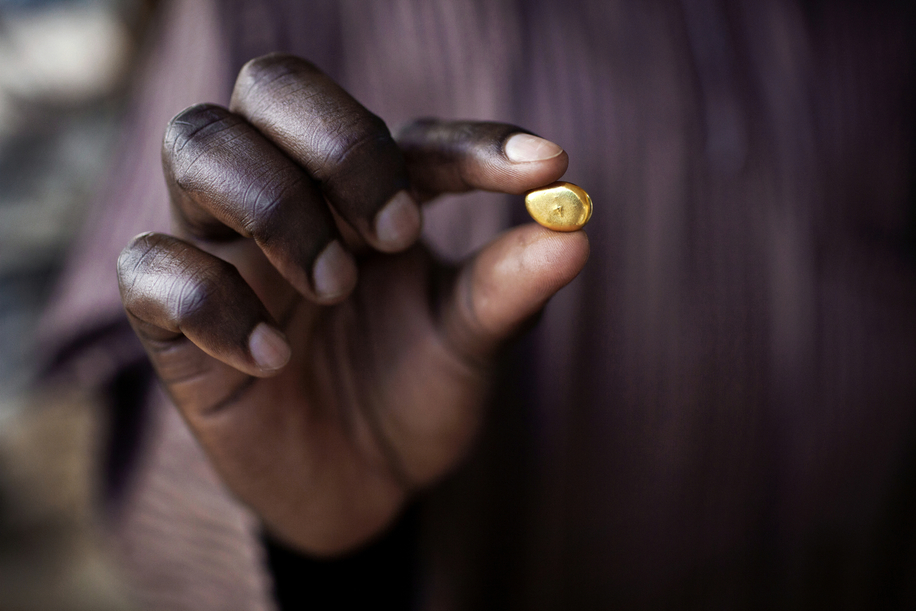

A gold trader is holding a piece of pure gold extracted in Zamfara State, while standing in the Zamfara Gold Buyers and Sellers Cooperative Union in Gusau, Zamfara State, Nigeria. The contamination in artisanal gold mining is caused by ingestion and breathing of lead particles released in the steps to isolate the gold from other metals. This type of lead is soluble in stomach acid and children under-5 are most affected, as they tend to ingest more through their hands by touching the ground, and are developing symptoms often leading to death or serious disabilities.
Dead End: The Nigerian Gold Rush and Lead Poisoning Crisis
Photographer: Alex Masi
Exhibit Title: Dead End: The Nigerian Gold Rush and Lead Poisoning Crisis
Location: Nigeria
In 2008 as the price of gold began skyrocketing on global markets, a cluster of several villages in rural Zamfara, northwest Nigeria, turned into the centre of a new, dangerous and uncontrollable gold rush.
The artisanal mines of Zamfara were soon visited by foreign gold traders and swamped by farmers, cattle herders, women and youngsters who had left their impoverished villages and their daily activities to become improvised miners: in a good day, they can earn as much as 100 US dollars, practically a small fortune in an area where 85 per cent of the people live below the poverty line of one dollar a day.
The villagers’ dreams of wealth soon became real-life nightmares, as mining activity unleashed what has been defined “the worst lead poisoning epidemic in modern history”: since the beginning of 2010, around 460 children under-five have died, while more than 5,000 have been contaminated by lethal levels of toxic lead, released from the stones being crushed to extract the precious metal.
An entire generation is slowly being wiped out: those who survive will experience incurable, long-term deficiencies such as blindness, hearing impairment and brain damage.
Artisanal mining have contaminated dozens of villages, together with water wells, fields, livestock and homes.
Despite the timely efforts of foreign NGOs, the people of Zamfara are now facing a deadly catch-22 situation: being the only profitable activity in the area, miners can't stop digging, but to feed their families they are destroying their own future, and that of their children.
Copyright: Alex Masi - 2012 - All Rights Reserved
My name is Alex Masi and I am an Italian documentary photographer deeply committed to spreading awareness - and supporting action towards children's rights.
After having completed a degree in Photojournalism at the London College of Communication in 2006, I have begun to investigate socio-environmental issues in countries such as India, Afghanistan, Iraq, and most recently in Nigeria.
Since then, I have devoted to exposing peculiar stories of human-made injustice, focusing mainly on children: their living conditions, their health and their human rights.
I strongly believes documentary photography ought to be an active catalyst in promoting awareness, political and juridical change, and in fostering action by individuals, NGOs and governments.
Photography is an essential channel for audiences to learn with immediacy, and to subconsciously empathise with other people facing realities away from our own immediate surroundings and personal experiences. I strive to portray my subjects with intimacy and meaning.
With my photographic skills, I aspire to convey emotions, and to present images that stimulate our deepest feelings: our sense of compassion, brotherhood and justice.
Medicins Sans Fronties (Doctors Without Borders)
http://www.doctorswithoutborders.org/news/allcontent.cfm?id=56
http://www.msf.org/
Alex Masi
Website: http://www.alexmasi.co.uk - http://www.alexmasi.com
Facebook Page: https://www.facebook.com/alexmasiphotography
Facebook: https://www.facebook.com/masi.alex
Twitter: https://twitter.com/AlexMasiPhoto
Email: alex@alexmasi.co.uk
Phone: 0044.755.734.3017
Make Comment/View Comments